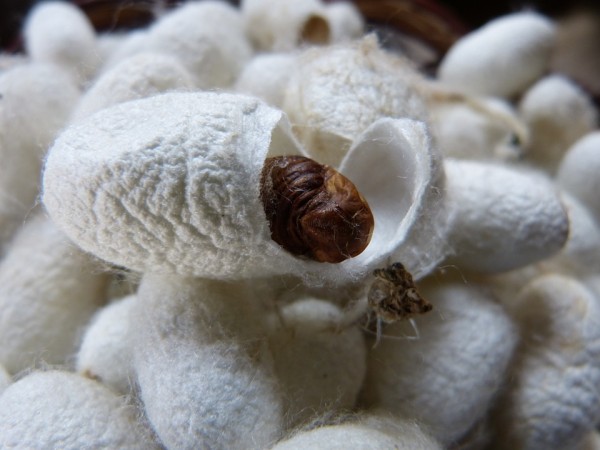By Ana Verayo, | October 11, 2016

A silkworm in its cocoon.
Researchers have fed silkworms carbon nanotubes and graphene to create the world's most durable material with silk.
In this new study, scientists from Tsinghua University in Beijing, China fed silkworms mulberry leaves that were coated in an aqua solution that contains 0.2 percent of graphene or carbon nanotubes. After the silkworms had spun their cocoons, researchers gathered this new silk hybrid.
Like Us on Facebook
Silkworms constantly eat mulberry leaves before they transform into a moth. Their salivary glands contain fibroin and sericin that help them create silk. Fibroin is the crucial component of silk. It is a durable solid material.
Silkworms emit liquid from their mouth, and this salivary liquid hardens as it gets exposed to air. The worm also secretes sericin which acts as the binding agent to glue these filaments together.
The carbon-enhanced silk created by the silkworms after eating carbon nanotubes is twice as tough as traditional silk material and can withstand 50 percent more stress. By warming these silk fibers to 1,050 degrees Celsius, scientists were able to carbonize the silk proteins and test their conductivity and overall structure. The new hybrid silk was found to have the ability to conduct electricity, unlike normal silk.
Researchers say that by feeding the worms, the strength of the hybrid silk can even be adjusted, making it more durable and tougher on a large scale.
Using spectroscopy and electron microscopy imaging, these carbon silk fibers revealed a more structured composition due to the nanomaterials.
This new study has been published in the journal Nano Letters.
-
Use of Coronavirus Pandemic Drones Raises Privacy Concerns: Drones Spread Fear, Local Officials Say

-
Coronavirus Hampers The Delivery Of Lockheed Martin F-35 Stealth Fighters For 2020

-
Instagram Speeds Up Plans to Add Account Memorialization Feature Due to COVID-19 Deaths

-
NASA: Perseverance Plans to Bring 'Mars Rock' to Earth in 2031

-
600 Dead And 3,000 In The Hospital as Iranians Believed Drinking High-Concentrations of Alcohol Can Cure The Coronavirus

-
600 Dead And 3,000 In The Hospital as Iranians Believed Drinking High-Concentrations of Alcohol Can Cure The Coronavirus

-
COVID-19: Doctors, Nurses Use Virtual Reality to Learn New Skills in Treating Coronavirus Patients







